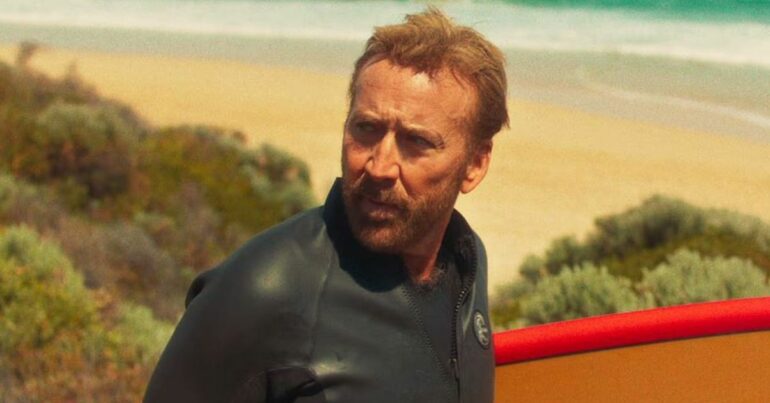Lorcan Finnegan’s The Surfer owes a considerable debt to Frank Perry’s 1968 psychological odyssey The Swimmer. Mind you, Burt Lancaster never had to contemplate eating a rat. Such behaviour, however, is absolutely in the wheelhouse of Nicolas Cage. While he is currently enjoying a resurgence thanks to some canny choices of scripts, Cage’s most notable performances of late have been more muted than his brand suggests. The likes of Dream Scenario or Pig require a greater degree of interiority than most of the direct-to-streaming stuff he’s made in recent times. The Surfer finds Cage at a midpoint between these registers, bringing both pathos and his unique manic energy to the role of a man who just wants to surf, but ends up in an ocean of trouble.
The Swimmer saw Burt Lancaster’s aging ad man swimming home through his neighbours’ pools as proof he was no longer inconsequential. In The Surfer, Cage’s unnamed waverider is attempting something a little more grounded, namely buying a home on a clifftop in a wealthy part of his Australian hometown, complete with perfect waves for surfing with his son (Finn Little). The only obstruction at the start are the bullying group of local men who drive strangers off the beach (“Ya ain’t local, ya ain’t surfin’!”), led by the handsomely punchable face of Julian McMahon’s Scally. Their opposition to the Surfer’s arrival is just the start of a series of setbacks that threaten his well-intentioned but fragile plans to set things right in his life. The slow buildup of inconveniences (A dead phone here, a missed phone call there), coupled with the violent hostility of the locals, would be enough to drive most men mad, and few sights are as cinematic as watching Nic Cage get mad.
There is nothing about Cage that sounds Australian (and thank goodness he doesn’t attempt an accent. Playing the surfer as American is a wise move). One could imagine the Western Australian setting being the result of tax breaks, but Finnegan finds purpose and beauty in it. DoP Radek Ladczuk capture the blazing red sunsets and seductive navy nights , while editor Tony Cranstoun goes to town on the action, bringing Finnegan’s wild colours and ambitious angles together in a riotous frenzy. Many a sequence just sees Cage looking down the barrel of the lens while it zooms in on his increasingly haggard looks. From its opening title care with the year denoted in roman numerals, The Surfer keeps nodding back to its melodramatic ‘60s forebears in its filmmaking technique.
Thomas Martin’s script is more complex than it first appears. From the simple premise of a man being intimidated out of buying a home, hints emerge of a haunted past. There are flashbacks to absent family and intrusive locals who hinder as much as they want to help (Nicolas Cassim’s turn as a local vagrant is both distancing and touching). All of this will be familiar to fans of Perry, and of the Australian New Wave. The woozy off-kilter feel of The Surfer is reminiscent of Wake In Fright, whose out-of-town protagonist also had to fend off local wildlife of all kinds to ensure his survival. As the Surfer finds himself pinned in place at the beach car park with no phone, car or food, a Buñuelian existentialism creeps into The Surfer, and Cage’s increasingly desperate actions invite pity as much as scorn. Cage keeps us on side throughout, never letting his increased desperation drive him into unlikability. You will find yourself cheering when he turns his rat-eating dilemma on one of his bullies.
As good as Cage is, though, he can’t prevent The Surfer from losing confidence in its own convictions. The existentialist dread that had been forming for most of the film is eschewed in the final act, and The Surfer begins to lose its bite. Add in a final five minutes that could be cut altogether, and you get a film that’s never as good as the forebears it invokes, but engages and entertains enough on its own terms. The Cage renaissance continues apace.
A release date for The Surfer has yet to be confirmed.

